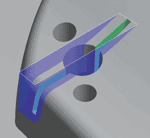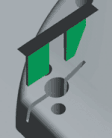Automating EDM Electrode Design For Mold Making
Many EDM electrode design steps are being automated, making electrode production faster and easier. Developments promise to streamline situations where EDMing is unavoidable, as well as make EDM attractive as the most efficient machining process in many cases where complex mold shapes are involved.
Share






Autodesk, Inc.
Featured Content
View More
.png;maxWidth=45)
DMG MORI - Cincinnati
Featured Content
View More
For decades, die/mold work has been a stronghold for ram-type electrical discharge machines. In fact, these machines are often referred to as diesinkers or sinker EDMs. But lately, there has been a trend away from EDM in favor of high speed machining and hard milling techniques. The advantage to these alternative processes has been the elimination of electrode production. Electrical discharge machining has always required the machining of a shaped electrode in copper or graphite. This is an added step imposed by the EDM process and is often a bottleneck. And before an electrode can be machined, numerous steps have to be completed by designers and NC programmers.
Now, many of those steps are being automated, making electrode production faster and easier. This development promises to streamline situations where EDMing is unavoidable. It also helps make EDM attractive as the most efficient machining process in many cases where complex mold shapes are involved.
Cimatron Limited, a CAD/CAM company primarily focused on software products for the die/mold industry, has introduced a CAD/CAM application package for automating the electrode process, called QuickElectrode. QuickElectrode can be used for burn area selection, electrode design, management, documentation and manufacture of solid or surface geometry. This software is designed to
- provide fast and accurate methods to identify burn areas,
- associatively extract burn areas from the workpiece,
- manipulate the burn area geometry to design the electrode,
- utilize standard libraries for blank, base, and holder sizes,
- automate electrode manufacturing, and
- automate electrode documentation.
According to the company, such a system must have analysis capabilities for the burn area selection, top-down assembly capabilities for extraction, advanced surface creation/modification tools for electrode design, bottom-up assembly capabilities for blanks, bases, and holders, high-end NC programming capabilities for electrode machining, and integrated detailing and drafting to document the EDM process. In short, the system must be capable of providing both CAD, CAM and drafting in a fully associative single database to meet this challenge.
Key features of QuickElectrode include:
- Burn area definition utilizing a dynamic drag and auto-extract technique.
- Selection of blank shapes and sizes from a standards list.
- “Fit Blank” and “Center Blank” functions that determine best-suited blank size with operator control of values.
- Dynamic clearance plane positioning to eliminate collisions between the electrode holder and the workpiece.
- A slide bar function that moves the electrode in and out of the core being burned, to check geometry and clearances visually on the screen display.
- Control over the display and activation of a single or group of electrodes, while allowing several users to work collaboratively on the same part.
- Electrode design modification tools to enable multi-surface tangent and linear extensions of burn area boundaries.
- Wizard-based construction of electrode blank and base with optional shape, size and location from standard library.
- Report generation that automatically creates setup sheets, burn locations and electrode schedule.
- Wizard-based automatic tool pathing for electrode machining.
Mold buyers are demanding shorter and shorter lead times to get their products to market. Process automation offers the most direct method of reducing lead times for mold making. Much has been written about how to effectively enhance ram EDM through spark efficiency, pulsing techniques, flushing methods, adaptive controls, dielectric fluids, and powder suspended fluids. Often overlooked is the impact that CAD/CAM can have on the electrode design and manufacturing process. Developments in this area may do more to swing the pendulum back to greater use of EDM than any improvement in the EDM process itself. MMS
Related Content
5 Tips for Running a Profitable Aerospace Shop
Aerospace machining is a demanding and competitive sector of manufacturing, but this shop demonstrates five ways to find aerospace success.
Read MoreTips for Designing CNC Programs That Help Operators
The way a G-code program is formatted directly affects the productivity of the CNC people who use them. Design CNC programs that make CNC setup people and operators’ jobs easier.
Read MoreContinuous Improvement and New Functionality Are the Name of the Game
Mastercam 2025 incorporates big advancements and small — all based on customer feedback and the company’s commitment to keeping its signature product best in class.
Read More4 Commonly Misapplied CNC Features
Misapplication of these important CNC features will result in wasted time, wasted or duplicated effort and/or wasted material.
Read MoreRead Next
5 Rules of Thumb for Buying CNC Machine Tools
Use these tips to carefully plan your machine tool purchases and to avoid regretting your decision later.
Read MoreBuilding Out a Foundation for Student Machinists
Autodesk and Haas have teamed up to produce an introductory course for students that covers the basics of CAD, CAM and CNC while providing them with a portfolio part.
Read MoreRegistration Now Open for the Precision Machining Technology Show (PMTS) 2025
The precision machining industry’s premier event returns to Cleveland, OH, April 1-3.
Read More

























.png;maxWidth=150)









.jpg;maxWidth=300;quality=90)

.jpg;maxWidth=300;quality=90)














